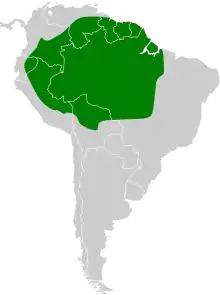| Black-throated antbird | |
|---|---|
%253B_Manaus%252C_Amazonas%252C_Brazil.jpg.webp) | |
| A male at Manaus, Amazonas state, Brazil. | |
| Scientific classification | |
| Domain: | Eukaryota |
| Kingdom: | Animalia |
| Phylum: | Chordata |
| Class: | Aves |
| Order: | Passeriformes |
| Family: | Thamnophilidae |
| Genus: | Myrmophylax Todd, 1927 |
| Species: | M. atrothorax |
| Binomial name | |
| Myrmophylax atrothorax (Boddaert, 1783) | |
 | |
| Synonyms | |
|
Myrmeciza atrothorax | |
The black-throated antbird (Myrmophylax atrothorax) is a species of passerine bird in the family Thamnophilidae. It is the only species in the genus Myrmophylax. It is found in Bolivia, Brazil, Colombia, Ecuador, French Guiana, Guyana, Peru, Suriname, and Venezuela.[1] Its natural habitats are subtropical or tropical moist lowland forests and heavily degraded former forest.[1]
Taxonomy
The black-throated antbird was described by the French polymath Georges-Louis Leclerc, Comte de Buffon in his Histoire Naturelle des Oiseaux in 1779.[2] The bird was also illustrated in a hand-coloured plate engraved by François-Nicolas Martinet in the Planches Enluminées D'Histoire Naturelle which was produced under the supervision of Edme-Louis Daubenton to accompany Buffon's text.[3] Neither the plate caption nor Buffon's description included a scientific name but in 1783 the Dutch naturalist Pieter Boddaert coined the binomial name Formicarius attothorax in his catalogue of the Planches Enluminées.[4] The species name is an error, the correct spelling is atrothorax. The type locality is the city of Cayenne in French Guiana.[5]
The black-throated antbird was usually placed in the genus Myrmeciza but a molecular phylogenetic study published in 2013 found that the genus was polyphyletic.[6] In the resulting rearrangement to create monophyletic genera the black-throated antbird was moved to the resurrected genus Myrmophylax which had originally been introduced the American ornithologist W. E. Clyde Todd in 1927.[7][8] The generic name Myrmophylax combines the Ancient Greek murmos meaning "ant" and phulax meaning "watcher" or "observer". The specific name atrothorax is from the Latin ater meaning "black" and thorax meaning "breast".[9]
Five subspecies are recognised.[7]
- Myrmophylax atrothorax metae (Meyer de Schauensee, 1947) – central Colombia
- Myrmophylax atrothorax atrothorax (Boddaert, 1783) – Venezuela, the Guianas and northeast Brazil
- Myrmophylax atrothorax tenebrosa (Zimmer, JT, 1932) – east Ecuador, northeast Peru and northwest Brazil
- Myrmophylax atrothorax maynana (Taczanowski, 1882) – north central Peru
- Myrmophylax atrothorax melanura (Ménétries, 1835) – east Peru, east, west Bolivia, southwest Brazil
References
- 1 2 3 BirdLife International (2018). "Myrmophylax atrothorax". IUCN Red List of Threatened Species. 2018: e.T22701851A130218074. doi:10.2305/IUCN.UK.2018-2.RLTS.T22701851A130218074.en. Retrieved 12 November 2021.
- ↑ Buffon, Georges-Louis Leclerc de (1779). "L'Alapi". Histoire Naturelle des Oiseaux (in French). Vol. 8. Paris: De l'Imprimerie Royale. p. 257.
- ↑ Buffon, Georges-Louis Leclerc de; Martinet, François-Nicolas (1765–1783). Planches Enluminées D'Histoire Naturelle. Vol. 8. Paris: De L'Imprimerie Royale. Plate 701 fig. 2, L'alapi de Cayenne.
- ↑ Boddaert, Pieter (1783). Table des planches enluminéez d'histoire naturelle de M. D'Aubenton : avec les denominations de M.M. de Buffon, Brisson, Edwards, Linnaeus et Latham, precedé d'une notice des principaux ouvrages zoologiques enluminés (in French). Utrecht. p. 44 Number 701 fig 2.
- ↑ Peters, James Lee, ed. (1951). Check-list of Birds of the World. Vol. 7. Cambridge, Massachusetts: Museum of Comparative Zoology. p. 238.
- ↑ Isler, M.L.; Bravo, G.A.; Brumfield, R.T. (2013). "Taxonomic revision of Myrmeciza (Aves: Passeriformes: Thamnophilidae) into 12 genera based on phylogenetic, morphological, behavioral, and ecological data" (PDF). Zootaxa. 3717 (4): 469–497. doi:10.11646/zootaxa.3717.4.3. PMID 26176119.
- 1 2 Gill, Frank; Donsker, David, eds. (2017). "Antbirds". World Bird List Version 8.1. International Ornithologists' Union. Retrieved 30 January 2018.
- ↑ Todd, W. E. Clyde (1927). "New gnateaters and antbirds from tropical America, with a revision of the genus Myrmeciza and its allies". Proceedings of the Biological Society of Washington. 40: 149–177 [172–173].
- ↑ Jobling, James A. (2010). The Helm Dictionary of Scientific Bird Names. London: Christopher Helm. pp. 60, 264. ISBN 978-1-4081-2501-4.
External links
